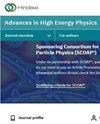Electron Number Density and Coherence Length of Boson-Fermion Pair in HTSC
IF 1.1
4区 物理与天体物理
Q3 PHYSICS, PARTICLES & FIELDS
引用次数: 1
Abstract
A Bose-Einstein Condensate (BEC) of a nonzero momentum Cooper pair constitutes a composite boson or simply a boson. Previously, it has been shown that the quantum coherence of the two-component BEC (boson and fermion condensates) is controlled by plasmons where < 1 % of plasmon energy mediates the charge pairing but most of the plasmon energy is used to overcome the modes that compete against superconductivity such as phonons, charge density waves, antiferromagnetism, and damping effects. The dependence of plasmon frequency on the material of a superconductor reveals that modes within a specific range of frequency enhance superconductivity and therefore affect the critical temperature of a particular superconducting material. Against this background, we study the effect on doping on boson-fermion pairing energy and hence the critical temperature. While most hole doping agents are atoms lighter than copper, many of the electron doping agents are materials heavier than copper. This property defines the doping effect on the plasma frequency. Heavier dopants lower the critical temperature while lighter dopants increase the critical temperature of a superconductor. The number density of electrons is also found to be proportional to the square of critical temperature T c while the size of a boson-fermion pair condensate (BFPC) is proportional to T c − 2 / 3 . The size of a BFPC particle is less than boson-fermion (BF) coherence length by almost an order.HTSC中玻色子-费米对的电子数密度和相干长度
非零动量库珀对的玻色-爱因斯坦凝聚(BEC)构成复合玻色子或简单的玻色子。以前,已经证明双组分BEC(玻色子和费米子凝聚体)的量子相干性是由等离子体控制的,其中等离子体能量的1%以下介导电荷对,但大部分等离子体能量用于克服与超导性竞争的模式,如声子、电荷密度波、反铁磁性和阻尼效应。等离子体频率对超导体材料的依赖揭示了特定频率范围内的模式增强了超导性,从而影响了特定超导材料的临界温度。在此背景下,我们研究了掺杂对玻色子-费米子对能和临界温度的影响。虽然大多数空穴掺杂剂是比铜轻的原子,但许多电子掺杂剂是比铜重的材料。这一性质决定了掺杂对等离子体频率的影响。较重的掺杂剂降低了超导体的临界温度,而较轻的掺杂剂提高了超导体的临界温度。电子数密度也与临界温度tc的平方成正比,而玻色子-费米子对凝聚体(BFPC)的大小与tc−2 / 3成正比。BFPC粒子的大小比玻色子-费米子(BF)相干长度小近一个数量级。
本文章由计算机程序翻译,如有差异,请以英文原文为准。
求助全文
约1分钟内获得全文
求助全文
来源期刊

Advances in High Energy Physics
PHYSICS, PARTICLES & FIELDS-
CiteScore
3.40
自引率
5.90%
发文量
55
审稿时长
6-12 weeks
期刊介绍:
Advances in High Energy Physics publishes the results of theoretical and experimental research on the nature of, and interaction between, energy and matter. Considering both original research and focussed review articles, the journal welcomes submissions from small research groups and large consortia alike.
 求助内容:
求助内容: 应助结果提醒方式:
应助结果提醒方式:


